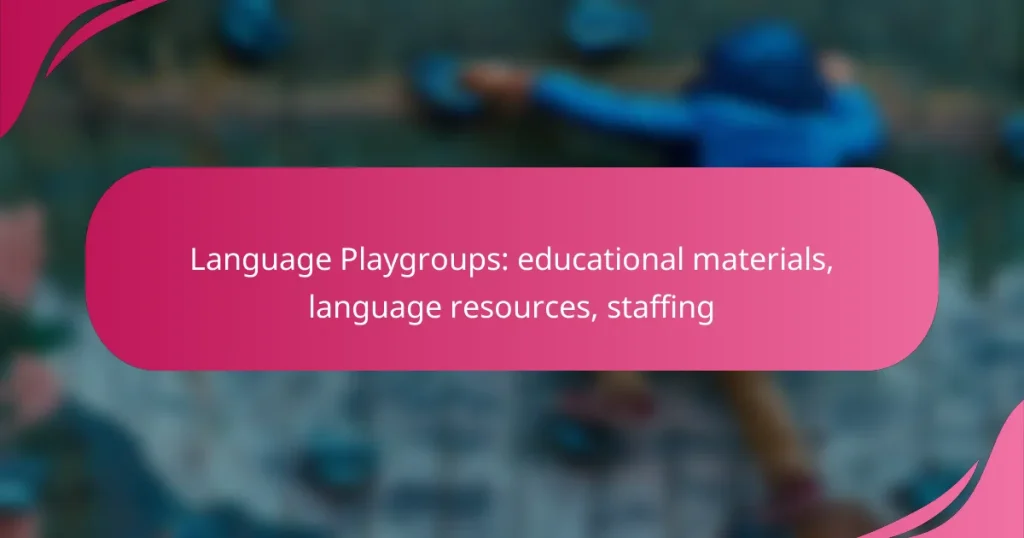Language playgroups are designed to enhance children’s language development through a variety of engaging educational materials, such as books, games, and multimedia tools. These resources not only stimulate communication skills but also foster a love for language in young learners. Additionally, effective staffing is essential, with a focus on qualified facilitators and appropriate staff-to-child ratios to create a supportive learning environment.
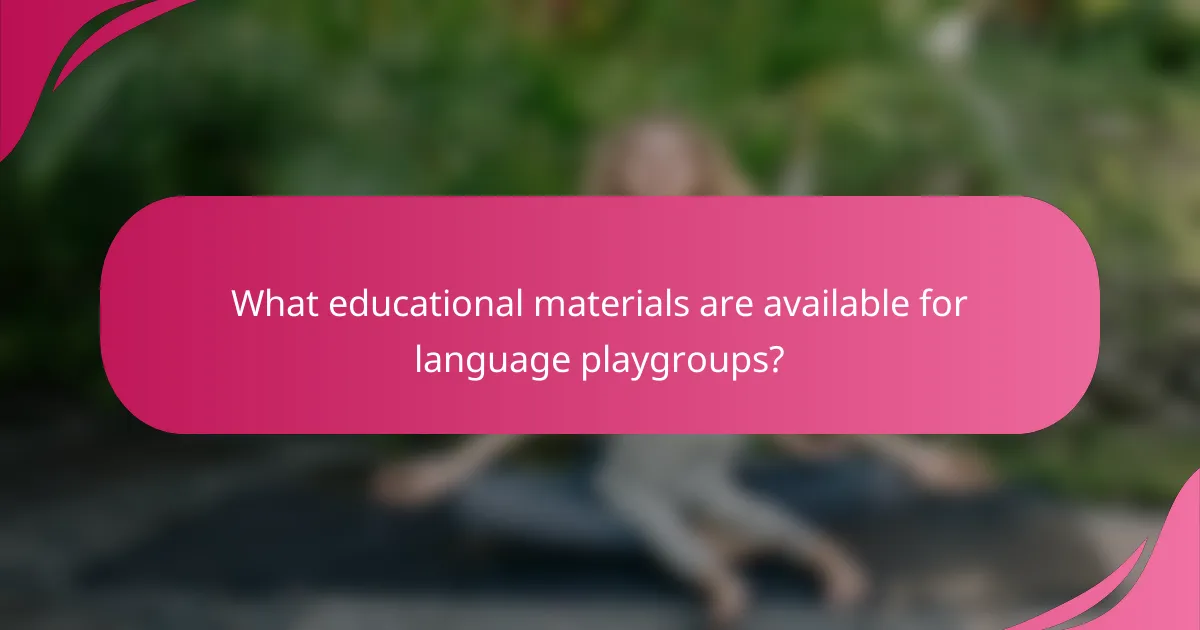
What educational materials are available for language playgroups?
Language playgroups can utilize a variety of educational materials to enhance language development. These resources include books, interactive games, multimedia tools, printable worksheets, and storytelling kits, each designed to engage children and foster their communication skills.
Books for early language development
Books are fundamental in language playgroups, providing a rich source of vocabulary and storytelling. Look for age-appropriate titles that feature colorful illustrations and engaging narratives to capture children’s attention. Popular choices include board books for toddlers and picture books for preschoolers.
Consider incorporating a mix of fiction and non-fiction to expose children to different language styles and concepts. Regular reading sessions can significantly boost language skills, with a focus on repetition and interactive questioning to enhance comprehension.
Interactive language games
Interactive language games are effective tools for making learning fun and engaging. Games like word matching, rhyming challenges, and vocabulary bingo encourage active participation and reinforce language concepts. These activities can be tailored to different age groups and language levels.
Incorporating movement into games, such as scavenger hunts for objects that start with specific letters, can also enhance engagement. Always ensure that the games are age-appropriate and consider the group dynamics to foster collaboration and communication among children.
Multimedia resources
Multimedia resources, such as educational videos and apps, can complement traditional materials in language playgroups. These resources often include songs, animations, and interactive storytelling that can captivate children’s interest and support auditory learning.
When selecting multimedia tools, prioritize those that are designed for educational purposes and align with language development goals. Monitor screen time to ensure it remains a small part of the overall learning experience, balancing it with hands-on activities.
Printable worksheets
Printable worksheets can provide structured activities that reinforce language skills through writing and drawing. These worksheets can include exercises like fill-in-the-blanks, matching words with images, or simple sentence construction tasks.
To maximize their effectiveness, tailor worksheets to the specific language abilities of the children in your playgroup. Ensure that the activities are engaging and visually appealing to maintain interest and encourage participation.
Storytelling kits
Storytelling kits can enhance creativity and language skills by providing children with the tools to create their own stories. These kits often include props, puppets, and story prompts that stimulate imagination and narrative skills.
Encourage children to collaborate on storytelling, which fosters communication and social skills. Regular storytelling sessions can help build confidence in language use and promote a love for narratives, making it a valuable addition to any language playgroup.
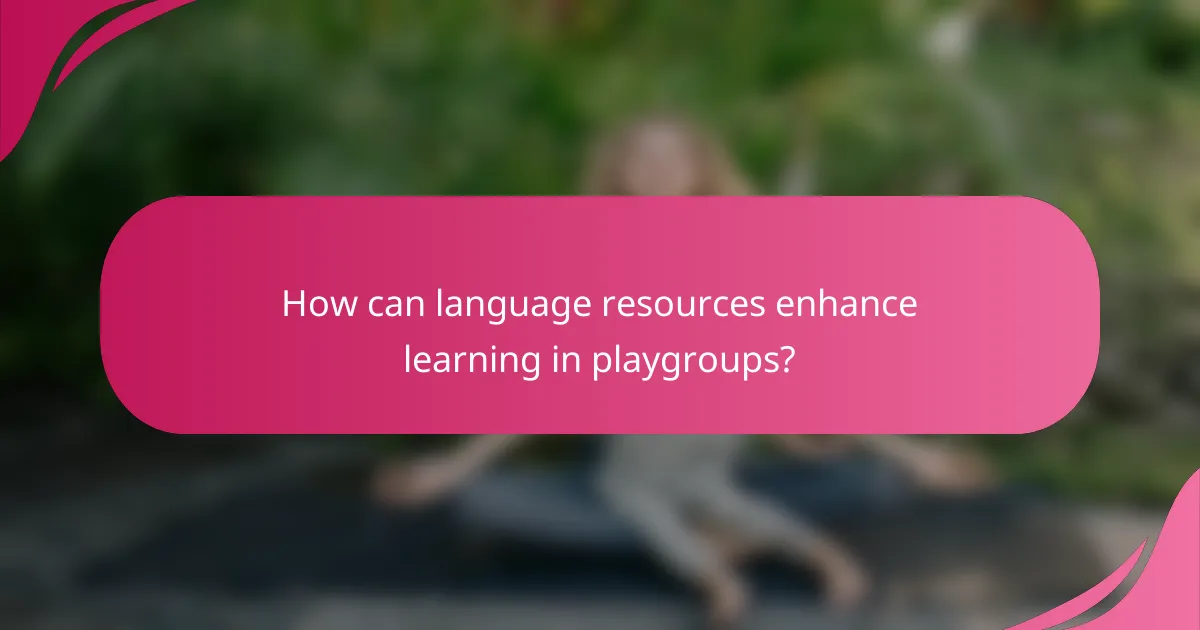
How can language resources enhance learning in playgroups?
Language resources significantly enhance learning in playgroups by providing engaging materials that stimulate children’s language development. These resources can include books, games, and interactive activities that promote communication skills and foster a love for language.
Promote vocabulary acquisition
Language resources play a crucial role in promoting vocabulary acquisition among young children. By exposing them to a variety of words through stories, songs, and interactive games, children can learn new terms in context, which aids retention. For example, using picture books that highlight everyday objects can help children connect words with their meanings.
Incorporating activities like word games or flashcards can further reinforce vocabulary learning. Aim for a diverse range of topics to keep children engaged and curious, which can lead to a broader vocabulary base over time.
Encourage social interaction
Language resources encourage social interaction by providing opportunities for children to communicate and collaborate. Group activities, such as storytelling sessions or role-playing games, require children to express their thoughts and listen to others, fostering essential social skills. This interaction not only enhances their language abilities but also builds confidence in their communication skills.
Creating a language-rich environment with resources like puppets or interactive storytelling can motivate children to engage with their peers. Encourage turn-taking and sharing during these activities to further promote social bonding and cooperative learning.
Support diverse learning styles
Language resources can support diverse learning styles by offering various methods for children to engage with language. Visual learners may benefit from illustrated books and videos, while auditory learners can thrive with songs and rhymes. Kinesthetic learners can engage with hands-on activities that involve movement, such as language games that require physical participation.
To cater to different learning preferences, consider incorporating a mix of resources in your playgroup. This approach ensures that all children have the opportunity to learn in a way that resonates with them, ultimately enhancing their language development and overall learning experience.
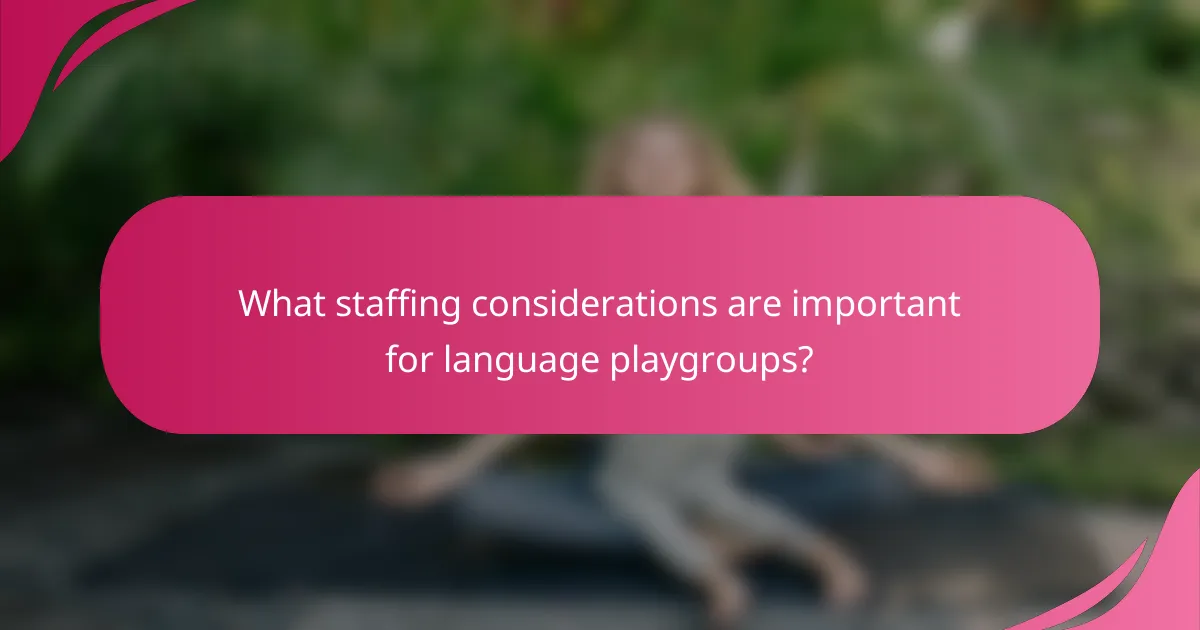
What staffing considerations are important for language playgroups?
Staffing for language playgroups is crucial for creating an effective learning environment. Key considerations include the qualifications of facilitators, appropriate staff-to-child ratios, and ongoing training opportunities to ensure quality language education.
Qualifications for language facilitators
Language facilitators should possess relevant qualifications, such as a degree in early childhood education, linguistics, or a related field. Additionally, experience in language teaching or child development is highly beneficial. Certifications in language instruction can further enhance a facilitator’s ability to engage children effectively.
Fluency in the target language is essential, as it allows facilitators to model pronunciation and usage accurately. Familiarity with various teaching methodologies can also improve the learning experience, enabling facilitators to adapt their approach to meet diverse needs.
Staff-to-child ratio guidelines
Maintaining an appropriate staff-to-child ratio is vital for effective language playgroups. A common guideline suggests a ratio of 1 staff member for every 5 to 10 children, depending on their age and language proficiency. Younger children or those with limited language skills may require smaller groups for more personalized attention.
Adhering to these ratios not only supports individual learning but also fosters a safe and engaging environment. Regular assessments of group dynamics can help determine if adjustments are necessary to optimize learning outcomes.
Ongoing training opportunities
Ongoing training for staff is essential to keep up with the latest language teaching strategies and educational technologies. Workshops, webinars, and peer collaboration can provide valuable insights and skills that enhance teaching effectiveness. Encouraging staff to pursue professional development opportunities can lead to improved outcomes for children.
Additionally, creating a culture of continuous learning within the playgroup can motivate staff to share best practices and innovative ideas. Regular feedback sessions can also help identify areas for improvement and foster a supportive team environment.
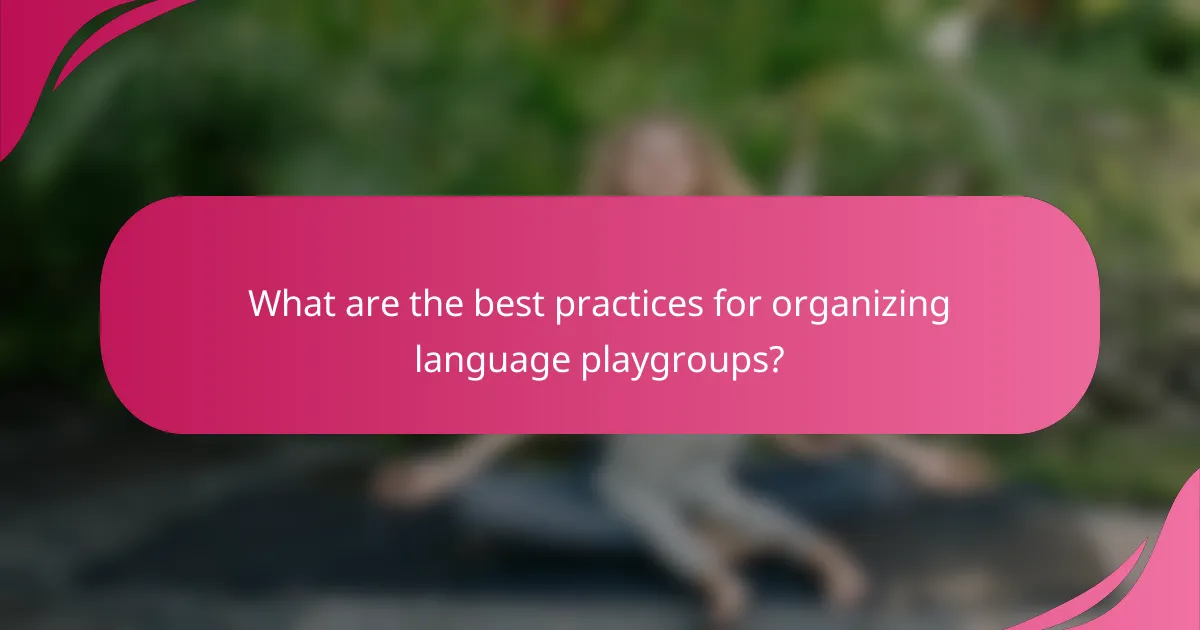
What are the best practices for organizing language playgroups?
Best practices for organizing language playgroups focus on creating an inclusive atmosphere, offering varied activities, and involving parents in the learning process. These elements enhance language acquisition and foster community among participants.
Creating a welcoming environment
A welcoming environment is crucial for encouraging participation in language playgroups. Ensure the space is comfortable, safe, and accessible, with seating arrangements that promote interaction. Use colorful decorations and age-appropriate materials to make the setting inviting.
Consider incorporating multilingual signs and labels to reflect the diverse languages represented in the group. This not only enhances the learning experience but also validates the cultural backgrounds of all participants.
Incorporating diverse activities
Diverse activities keep language playgroups engaging and cater to different learning styles. Include storytelling, songs, games, and hands-on crafts that incorporate language use. Activities should be designed to promote interaction and communication among children.
For example, you can organize role-playing scenarios that encourage children to use new vocabulary in context. Rotating activities weekly can help maintain interest and ensure that all language skills—listening, speaking, reading, and writing—are addressed.
Engaging parents in the process
Engaging parents is essential for reinforcing language learning at home. Provide parents with resources and strategies they can use to support their children’s language development outside of playgroup sessions. Regular newsletters or workshops can keep parents informed and involved.
Encourage parents to participate in activities, whether by leading a session or sharing cultural stories and songs. This involvement not only strengthens the parent-child bond but also enriches the playgroup experience for all participants.
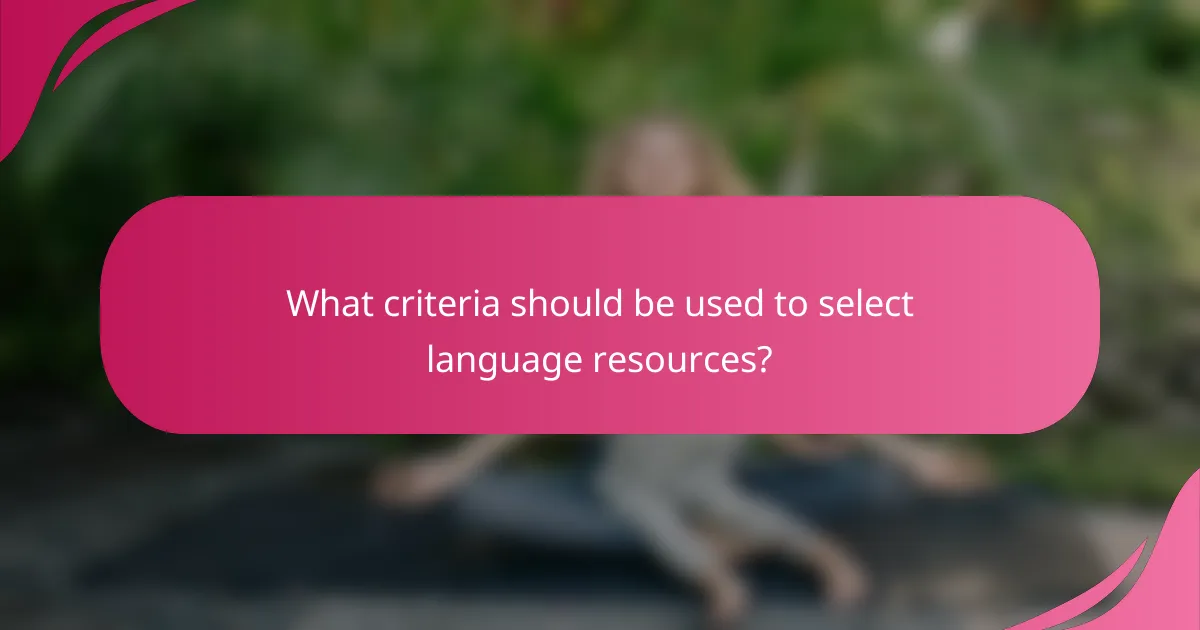
What criteria should be used to select language resources?
Selecting language resources requires careful consideration of several criteria to ensure they meet the needs of learners effectively. Key factors include age appropriateness, cultural relevance, and alignment with educational standards.
Age appropriateness
Age appropriateness refers to how suitable a resource is for a specific age group in terms of language complexity and content. Resources should match the developmental stages of learners, ensuring that materials are neither too challenging nor too simplistic.
For example, resources for preschoolers might include colorful picture books and simple songs, while materials for older children could involve interactive games or chapter books. Always consider the cognitive and emotional maturity of the target age group when selecting resources.
Cultural relevance
Cultural relevance ensures that language resources reflect the backgrounds and experiences of the learners. This fosters engagement and helps students connect with the material on a personal level.
Incorporating stories, examples, and characters from diverse cultures can enhance learning. For instance, using bilingual books that represent various cultures can be beneficial in a multicultural classroom. Avoid resources that may perpetuate stereotypes or exclude certain groups.
Alignment with educational standards
Alignment with educational standards is crucial for ensuring that language resources support the curriculum and learning objectives. Resources should adhere to local or national educational guidelines to facilitate effective teaching and assessment.
Check if the materials align with standards such as the Common Core State Standards in the U.S. or similar frameworks in other countries. This alignment helps educators track progress and ensures that learners acquire necessary skills in language development.
